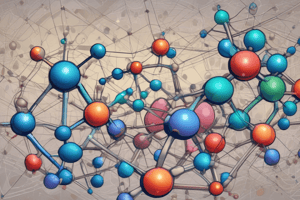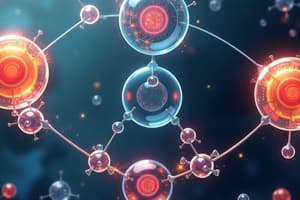Podcast
Questions and Answers
What is the main difference between the Dewar–Chatt (D-C) model and the metalacyclopropane (MCP) model?
What is the main difference between the Dewar–Chatt (D-C) model and the metalacyclopropane (MCP) model?
The main difference is the strength of back bonding, with the D-C model applicable for weak back bonding and the MCP model for strong back bonding.
Why does the alkene C=C bond length, dCC, increase on binding to the metal?
Why does the alkene C=C bond length, dCC, increase on binding to the metal?
The alkene C=C bond length, dCC, increases on binding due to the depletion of the C=C π bond by donation to M and back donation from the metal that lowers the alkene C−C bond order.
What is the effect of electron-withdrawing substituents on the M-(alkene) bond?
What is the effect of electron-withdrawing substituents on the M-(alkene) bond?
Electron-withdrawing substituents on carbon encourage back donation and strengthen the M-(alkene) bond.
What is the difference in the C=C bond length between free C2H4 and Pt(II) complex?
What is the difference in the C=C bond length between free C2H4 and Pt(II) complex?
What is the extreme of the MCP model, and how does it resemble?
What is the extreme of the MCP model, and how does it resemble?
How does the oxidation state of the metal affect the model that applies?
How does the oxidation state of the metal affect the model that applies?
What is the difference in the C–H bonds between the D-C and MCP models?
What is the difference in the C–H bonds between the D-C and MCP models?
What is the name of the model that applies to Pt(0) complexes, and why is it named so?
What is the name of the model that applies to Pt(0) complexes, and why is it named so?
What is the result of the p orbital on the carbon pointing more directly towards the metal in an η3-allyl complex?
What is the result of the p orbital on the carbon pointing more directly towards the metal in an η3-allyl complex?
What kind of exchange is often seen in the η3-allyl group?
What kind of exchange is often seen in the η3-allyl group?
What is the proposed mechanism of the Ru case in Eq. 5.28 and Eq. 5.29?
What is the proposed mechanism of the Ru case in Eq. 5.28 and Eq. 5.29?
What is the common mechanism that involves an η1-allyl intermediate?
What is the common mechanism that involves an η1-allyl intermediate?
What is the general reaction illustrated in Eq. 5.29?
What is the general reaction illustrated in Eq. 5.29?
What is the significance of the nomenclature of syn and anti substituents?
What is the significance of the nomenclature of syn and anti substituents?
How can the ligand 5.19 be best pictured on binding?
How can the ligand 5.19 be best pictured on binding?
What is the first route to allyl complexes, as shown in Eq. 5.14?
What is the first route to allyl complexes, as shown in Eq. 5.14?
What is the result of the electrophilic attack on a diene complex in Eq. 5.17?
What is the result of the electrophilic attack on a diene complex in Eq. 5.17?
What is the result of the umbrella distortion from the ideal planar conformation of the ligand?
What is the result of the umbrella distortion from the ideal planar conformation of the ligand?
What is the significance of the cyclopentadienyl group (Cp) in organometallic transition metal π complexes?
What is the significance of the cyclopentadienyl group (Cp) in organometallic transition metal π complexes?
What is Markovnikov's rule, as shown in Eq. 5.18?
What is Markovnikov's rule, as shown in Eq. 5.18?
What is the result of the hydride adding to the central carbon in Eq. 5.19?
What is the result of the hydride adding to the central carbon in Eq. 5.19?
What is the structure of ferrocene, Cp2Fe, discovered by Wilkinson, Woodward, and Fischer?
What is the structure of ferrocene, Cp2Fe, discovered by Wilkinson, Woodward, and Fischer?
What are the common types of complexes formed by the cyclopentadienyl group (Cp)?
What are the common types of complexes formed by the cyclopentadienyl group (Cp)?
What is the limitation of the cyclopentadienyl group (Cp) as a spectator ligand?
What is the limitation of the cyclopentadienyl group (Cp) as a spectator ligand?
What is the oxidation state of the metal M in the electron-deficient 16e species Cp2MX2?
What is the oxidation state of the metal M in the electron-deficient 16e species Cp2MX2?
How many electrons do the Cp2Mo and Cp2W fragments have before bonding with ligands?
How many electrons do the Cp2Mo and Cp2W fragments have before bonding with ligands?
What happens to the nonbonding orbital in the metallocene dichloride Cp2MoCl2?
What happens to the nonbonding orbital in the metallocene dichloride Cp2MoCl2?
What type of ligands can stabilize the unsaturated ligands in the [Cp2M(C2H4)Me]+ complex?
What type of ligands can stabilize the unsaturated ligands in the [Cp2M(C2H4)Me]+ complex?
What is the result of protonating the lone pair between the hydrides in Cp2MH2?
What is the result of protonating the lone pair between the hydrides in Cp2MH2?
How many available orbitals are used in the Cp2MH2 complex?
How many available orbitals are used in the Cp2MH2 complex?
What is the electron count of the Cp2Re fragment?
What is the electron count of the Cp2Re fragment?
How many X ligands can bind to the Cp2M fragments from the group 5 metals?
How many X ligands can bind to the Cp2M fragments from the group 5 metals?
What is the role of Tp ligands with substituents at the 5-position in some metal complexes?
What is the role of Tp ligands with substituents at the 5-position in some metal complexes?
What is the significance of [Cr(η6-C6H6)2] in the field of organometallic chemistry?
What is the significance of [Cr(η6-C6H6)2] in the field of organometallic chemistry?
What is the typical mode of binding of arenes to metals?
What is the typical mode of binding of arenes to metals?
How does the binding of an arene to a metal affect the C-C distances within the ring?
How does the binding of an arene to a metal affect the C-C distances within the ring?
What is the difference between arene and Cp ligands in terms of reactivity?
What is the difference between arene and Cp ligands in terms of reactivity?
What is the typical synthetic route for preparing arene complexes?
What is the typical synthetic route for preparing arene complexes?
What is the effect of arene binding on the electron density of the ring?
What is the effect of arene binding on the electron density of the ring?
What is the role of reducing agents in the synthesis of arene complexes?
What is the role of reducing agents in the synthesis of arene complexes?
What is the geometry of the η4 arene ring in metal complexes?
What is the geometry of the η4 arene ring in metal complexes?
How do arene ligands differ from Cp ligands in terms of their behavior in metal complexes?
How do arene ligands differ from Cp ligands in terms of their behavior in metal complexes?
Flashcards are hidden until you start studying
Study Notes
Models of Metal-Alkene Binding
- The Dewar-Chatt (D-C) model holds for weak back bonding, while the metalacyclopropane (MCP) model applies for strong back bonding.
- Experimental structures can exhibit characteristics of both models, with the D-C model fitting best for Zeise's salt and other intermediate oxidation state late metals, and the MCP model applying for Pt(0).
- Both models are considered η2 structures.
Factors Affecting Alkene C=C Bond Length
- The M-alkene σ bond depletes the C=C π bond, slightly weakening and lengthening the bond.
- Back donation from the metal reduces the alkene C-C bond order, further increasing the bond length.
- The extent of back donation depends on the metal, with weakly π-basic Pt(II) resulting in a slight increase in bond length, and strongly π-basic Pt(0) resulting in a more significant increase.
Metalacyclopropane (MCP) Model
- The MCP model applies for strong back bonding, with the alkene C=C bond lengthening to 1.43 Å.
- The C-H bonds fold back strongly, with the carbons rehybridized from sp2 to sp3.
- The MCP extreme resembles a [C2H4]2- dianion, with LnM replacing one CH2 in cyclopropane.
Effects of Substituents on Alkene Binding
- Electron-withdrawing substituents on carbon encourage back donation and strengthen the M-alkene bond.
- For example, Pt(PPh3)2(C2CN4) has a dCC of 1.49 Å, approaching the C-C single bond length.
Synthetic Routes
- Synthetic routes for metal-alkene complexes include reactions involving oxidative addition, oxidative coupling, and reductive elimination.
Trimethylenemethane Complexes
- Trimethylenemethane is a highly unstable ligand in the free state, but can be stabilized by binding to a metal.
- The ligand exhibits an umbrella distortion, moving the central carbon away from the metal and improving M-L overlap.
Cyclopentadienyl Complexes
- Cyclopentadienyl (Cp) is a central ligand in organometallic transition metal π complexes, being the most firmly bound polyenyl and the most inert to nucleophiles and electrophiles.
- Cp is a reliable spectator ligand in metallocene and CpMLn complexes.
Synthesis of Cyclopentadienyl Complexes
- Synthetic routes for cyclopentadienyl complexes include reactions involving oxidative addition, oxidative coupling, and reductive elimination.
π-Complexes
- π-Complexes exhibit exchange of syn and anti substituents, which can affect the appearance of the 1H NMR spectrum.
- A common mechanism for this exchange involves an η1-allyl intermediate.
Arene Complexes
- Arene complexes are typically synthesized through reactions involving the arene and a reduced metal, or the arene, a metal salt, and a reducing agent.
- Arenes usually bind in the 6e, η6-form, but η4 and η2 structures are also seen.
- The C-C distances in arene complexes are usually essentially equal, but slightly longer than in the free arene.
Reactivity of Arene Complexes
- Arenes are more reactive than Cp groups and are more easily lost from the metal.
- Arenes are often actor ligands, rather than spectator ligands.
Studying That Suits You
Use AI to generate personalized quizzes and flashcards to suit your learning preferences.




